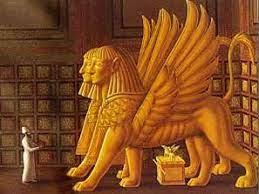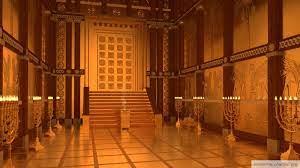Inside Solomon’s Temple
First Kings 6:15-38 and Second Chronicles 3:8-14
Inside Solomon’s Temple DIG: In what ways does Solomon demonstrate the importance he attaches to the Temple? Why is so much value given to this building? What art adorns the Temple (1 Kings 6:23-29)? What are cherubim (Gen 3:24)? Why does Jewish art avoid any human depictions (Deut 5:8)? Does the Temple say anything about the character of God?
REFLECT: What kind of “temple” is God building (Ephesians 2:19-22)? How is the progress in the corner of the project assigned to you? To your place of worship? Is the project “noise-free” or “full of static?” Explain. How will the laborers be supported? What sacrifices will be needed? When you enter the presence of God do you have a sense of awe? Why? Why not?
Seeing the cherubim would impress anyone of the holiness of ADONAI.
The fire that devastated England’s Windsor Castle in 1992 was a costly disaster. To help pay for the repairs, which cost millions of pounds, Queen Elizabeth II opened her home to visitors. For the first time in history, common tourists could pay a small fee for the unprecedented privilege of walking through Buckingham Palace. The opening of the palace offered a rare glimpse of the queen’s royal splendor. To know what people are like, it helps to see where they live, and for the queen of England, home is where the majesty is. People who were fortunate enough to visit Buckingham Palace saw the queen’s royal apartments, with their gilded ornaments and famous masterpieces. They walked through her stately private gardens. They encountered her receiving room to gaze upon her golden throne. To see the royal palace was to experience the glory of Queen Elizabeth’s kingdom.
The Bible gives us a similar experience by taking us on a guided tour of Solomon’s Temple, the house of God. Sometimes people wonder what YHVH is really like. Since we have never seen Him face-to-face, it can be hard to get a clear impression of his true and awesome glory. Visiting the house that Solomon built can help us to know God better, for when we look at the building carefully, seeing the plan for its structure and the details of its design, we learn the character of ADONAI who made His home there.123
Natural beauty: The first thing we notice inside Solomon’s Temple is its natural beauty. The insides of the walls of the house he built with boards of cedar: from the floor of the house to the joists of the ceiling he covered them on the inside with wood, and he covered the floor of the house with boards of cypress. The thirty-five-foot back portion of the house he built with boards of cedar from the floor to the joists and reserved this part of the house to be a sanctuary, the Most Holy Place; while the rest of the house, that is, the Temple in front, was seventy feet long. The cedar covering the house was carved with gourds and open flowers; all was cedar; no stone was visible (First Kings 6:15-18).
Solid gold: In the inner part of the house he set up the Sanctuary, so that the ark for the covenant of ADONAI (see the commentary on Exodus, to see link click Fr – The Ark of the Covenant in the Most Holy Place: Christ at the Throne of Grace), containing the Ten Commandments, could be placed there (First Kings 6:19). On top of the ark was the mercy seat (see Exodus Fs – The Mercy Seat in the Most Holy Place: Christ at the Throne of Grace). It was there that the high priest sprinkled the blood on the Day of Atonement (see the commentary on Leviticus Ef – Yom Kippur). Thus, the ark in the Most Holy Place was the focal point of the Temple and its ritual, not as an object of worship itself, or superstitious awe, but as the place where His Sh’khinah glory, the very presence of God, dwelt among His people.124
Dear Heavenly Father, How spectacular and beautiful the Most Holy Place, all covered in gold! Yet even more awesome is that Your very presence, Your Sh’khinah glory that resided in the Most Holy Place above the ark. Your presence is even more spectacular than gold! What a privilege it is that You dwell in my heart: Yeshua answered and said to him: If anyone loves Me, he will keep My word. My Father will love him, and We will come to him and make Our dwelling with him (John 14:23) – now that sin has been paid for by Yeshua, the Lamb of God (John 1:29). How important it is to always keep any place of worship clean. In the same way, it is so important to keep my heart/life clean because You live inside me. Or don’t you know that your body is a temple of the Ruach Ha’Kodesh who is in you, whom you have from God, and that you are not your own (First Corinthians 6:19)? It is a joy and delight to please You! In Yeshua’s holy name and power of His resurrection. Amen
Holy, Holy, Holy: The Temple was the guardian of, and witness to, the Torah. In common with ancient Near Eastern principles of religious architecture, the holiest place was to be a perfect cube which symbolized the perfection of its design as well as its purpose.125 Then he made the Most Holy Place thirty-five feet long, wide and high; and it was overlaid with twenty tons of pure gold. In front of it, Solomon set an altar, which he covered with cedar. He overlaid the interior of the house with pure gold and had chains of gold hung across the doors that led to the Most Holy Place, which itself he overlaid with gold. The entire house he overlaid with gold until it was completely covered with it. He also overlaid with gold the entire altar that belonged to the Sanctuary. All around the walls of the house, both inside the sanctuary and outside it, he carved figures of cherub, palm trees and open flowers. He overlaid the floor of the house with gold, both inside the Sanctuary and outside it (First Kings 6:20-22 and 29-30; Second Chronicles 3:8-9).

Inside the Most Holy Place he made two cherubim of olive-wood, then cast metal, overlaid with gold. These two magnificent statutes dominated the Most Holy Place. The wings of the cherubim were thirty-five feet long, completely spanning the inner Sanctuary — the wings of both cherubs was eight-and-three-quarters feet long and touched the wall of either side of the house and met in the middle of the room. Each cherub was seventeen-and-a-half feet tall and stood on their feet facing the door (First Kings 6:23-30; Second Chronicles 3:10-13). These two figures (Ezeki’el 1:4-14) represented the cherubim associated with the throne and government of YHVH (Ezeki’el 1:22-28). They also served as the guardians of the way to God (Genesis 3:24). The impact on the beholder of these representations of the cherubim would be to impress on that person the awesomeness of ADONAI’s holiness. Approaching the LORD is not a light or frivolous matter and must be undertaken in the exact way He has prescribed – through the blood of the sacrifice.126
Just before the two cherubim, and hiding them and the Most Holy Place from the Holy Place, was a richly embroidered veil made of blue, purple and crimson material and of fine linen, with a design of cherubim worked into it (Second Chronicles 3:14). Only here in the TaNaKh is this mentioned. Of course, the Tabernacle had an inner veil (see Exodus Fq – The Inner Veil of the Sanctuary: That is Christ, His Body). Herod’s Temple also had this veil (see the commentary on The Life of Christ Lw – The Accompanying Signs of Jesus’ Death). The Chronicler was interested in the veil because its continuity with the Tabernacle, but for believers, the tearing of the veil when Yeshua died (Matthew 27:51) supersedes all other associations (to see a video of Solomon’s Temple in 3D click here).127

Leaving the Most Holy Place, we can see that the doors were made of olive-wood, set within a five-sided door-frame. On the two olive-wood doors he carved figures of cherubim, palm trees and open flowers. He overlaid the doors with gold, forcing the gold into the shapes of the cherubim and palm trees as well. For the entrance to the Temple, he also made doorposts of olive-wood, set within a rectangular door-frame, and two doors of cypress-wood; the two leaves of the one door were folding, as were the two leaves of the other. On them he carved cherubim, palm trees and open flowers, overlaying them with gold fitted to the carved work (First Kings 6:31-35). From this and the following verses in this chapter, and in Chapter 7, it is quite evident that Solomon spared no expense in building the Temple; he used the finest and costliest materials available. His prayer in Chapter 8 makes it clear that in doing so, Solomon was giving expression to his sincere love for, and devotion to, ADONAI. Though God could not be enriched, Solomon was demonstrating in a practical way that nothing but the best is owed to the LORD. This is an enduring principle for believers in every age and ought to find expression in every area of our lives.128
Having quickly toured the interior of the Temple and passed through the two doors of cypress-wood that stand at its entrance, we find ourselves once more in the inner courtyard, passing between two free-standing pillars Jachin and Boaz (see Be – Two Bronze Pillars). He built the inner courtyard with three rows of cut stone and a row of cedar beams (First Kings 6:36). It was an open plaza surrounding the Temple. This inner courtyard, also called the courtyard of the priests (Second Chronicles 4:9), was separated from the great outer court by the wall described here. The size of the inner courtyard is not given, but if the dimensions of the Temple are proportionate to those of the Tabernacle courtyard, as the dimensions of the Sanctuaries of the Temple and Tabernacle are, the inner courtyard was about one-hundred-and-fifty feet wide and four-hundred feet long.129
The foundation of the house of ADONAI was laid in the fourth year, in the month of Ziv. In the eleventh year, in the month of Bul (the eighth month), which is the eighth month, all parts of the house were completed exactly as designed. Thus, he spent seven years building it (First Kings 6:37-38). About seven years and six months were needed to complete the Temple. An enormous amount of labor and funds were involved. All the plans of David were carried out. It must have been a moment of great satisfaction to Solomon to see the desires of his father’s heart come true; and when ADONAI acknowledged the Temple by filling it with His Sh’khinah glory, Solomon’s joy, I am sure, knew no bounds.130 The Temple stood for nearly four centuries and was the only structure that was rebuilt after the exile in Babylon. As time passed, the nation learned to look at the Temple as a sign of their relationship with YHVH. For the time being, however, the people needed to make the transition from a more basic Tabernacle to the new, ornately decorated Temple.131



Leave A Comment